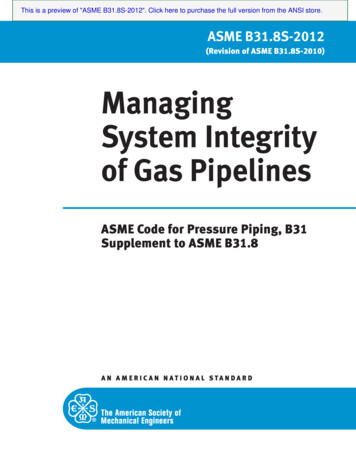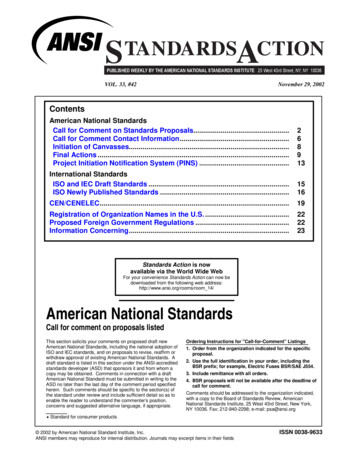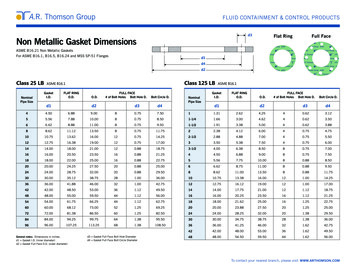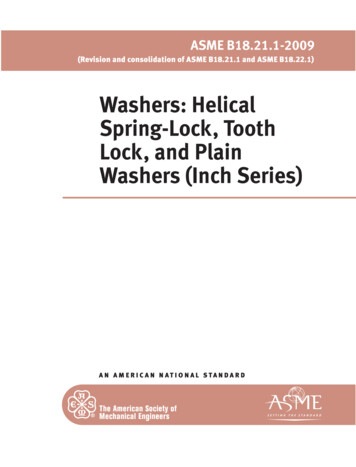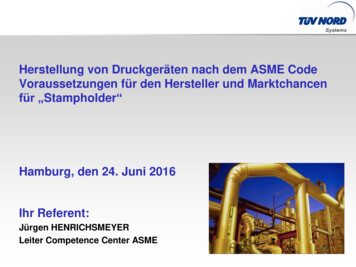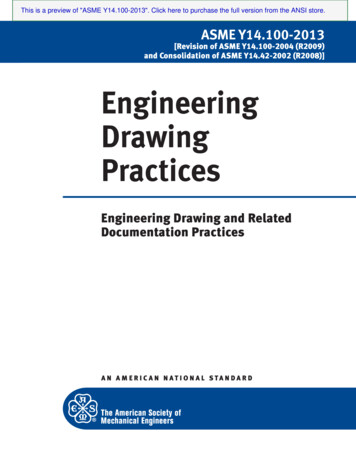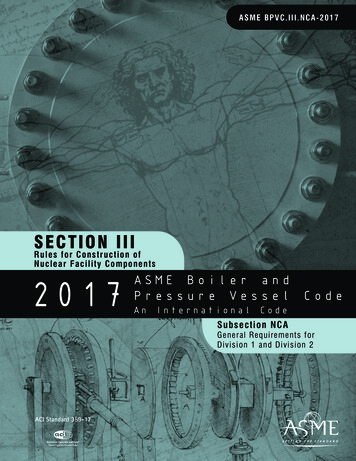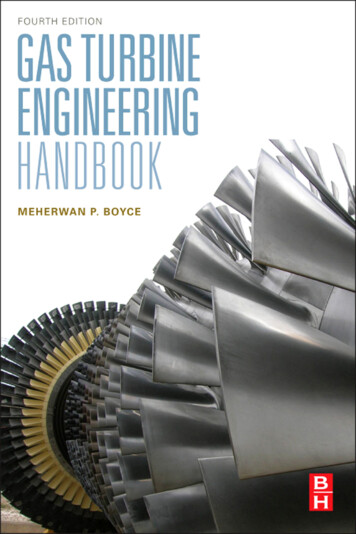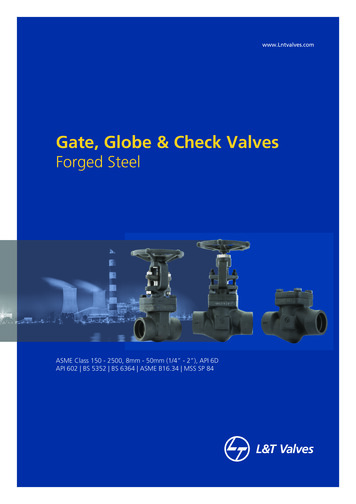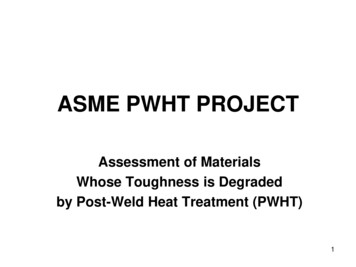
Transcription
ASME PWHT PROJECTAssessment of MaterialsWhose Toughness is Degradedby Post-Weld Heat Treatment (PWHT)1
O’Donnell GroupDegradation of Toughness by PWHT Members:- W. D. Doty- W. J. O’Donnell- C.E. Spaeder2
Comment on Dor Doty Many of you recognize that Dr. Doty was amajor contributor to the NBIC rules formany years. He served as my mentor since 1960. This presentation is dedicated to Dor Doty.3
Presentation Format Background of present code rules.Overview of PWHT Issues.Stress Relieving (PWHT) ASTM A212.Flaw Size vs. Fatigue Life per Barsom.PWHT of Modern Steels.Review of Selected Documents.ID items that need to be reconsidered bythe Code.4
Terms Used Interchangeably Reheat Cracking PWHT post weld heat treatment (PWHT)5
Project Background PWHT reported as highly desirable in the early 50s. Beneficial notion became ingrained in common “inhouse” welding programs. PWHT can be detrimental for certain steels. PWHT has no benefit for some modern steels. Need to apply technology from other industries;example: fracture control plan as applied to bridges.6
Overview of PWHT EffectsBeneficial Effects Improve toughness of certain steels; especiallysteels with relatively high carbon. Mitigate SCC in some Service. Outgas hydrogen. (Need can be mitigated bystrict low hydrogen practices). Reduce residual stresses; important in SCCservice and for dimensional control aftermachining.7
Overview of PWHT EffectsDetrimental Effects Degrade toughness for some steels. Introduce micro cracks not readily foundby routine NDE. It is difficult to rule out reheat crackingbecause of the complexity of the HAZ.8
Pellini on Residual Stressin Structures Residual Stress is important in terms ofbrittle fracture only with low toughness. When a PWHT is undesirable, elasticplastic toughness corresponding to thepresence of stresses equal to yieldstrength values should be required. Thistoughness value allows the omission of aPWHT in the absence of issues such asSCC and dimensional considerations.9
Stress Relieving (PWHT )ASTM A21210
Flaw Size vs. Fatigue Life11
Comments on Previous SlideBriefly:1. Very important in understanding the role of notch toughness andinter relationships among cracks and crack-like flaws, stress range,and fatigue life. (on cover of Barsom book)2. Stress range is critical because crack growth rate is proportional tothe power 3.3. Role of stress concentration effects needs to recognized.4. Elastic-plastic behavior in desirable in most ASME applications.5. Crack arrest can be achieved with some steels that exhibit very hightoughness.6. Some low carbon high strength steels exhibit toughnessapproaching that of austenitic stainless steels such as Type 304.12
PWHT on Modern Steels ASTM 709 –(High Performance Steel)Designed for ease of welding.Toughness similar to austenitic steel.Exhibits yield strengths as high as 100 ksi.Low carbon martensitic steels similar toASTM A517 steel except carbon is keptlow.These types of steel can be susceptible toPWHT cracking.13
Background Documents Documents considered in following order:1. WRC Bulletins.2. Doty Papers3. TWI documents-March 2006 WeldingJournal.14
Stout Bulletin 302 Good overview of PWHT issues:1.2.3.4.5.Benefit of PWHT for 0.25% carbon steels.Marginal benefit for 0.15% carbon steels.V bearing steels often degraded by PWHT.PWHT not a universal good.Not required if residual stress can be dealtwith successfully.6. Little benefit with respect to fatigue.15
Konkol Bulletin on Long-Time Effects Studies on ASTM A36, A537 Class 1,A612, A588 Grade A, A572 Grade 50,A663 Grade C, and A633 Grade E show:1. Base metal strength and notch toughnessare generally degraded by long PWHT.2. HAZ and Weld Metal toughness areaffected by welding parameters.3. HAZ sometimes benefit from PWHT andsometimes degraded.16
WRC Bulletin 395 Lehigh studies on V and Cb additionsshow:1. These additions degrade the CVN ofnormalized and tempered base metal andHAZ properties.2. The level of degrading is a function ofspecific composition and welding paramters.17
WRC Bulletin 407 Spaeder-Doty Interpretive report shows:1. The ASME Code permits the elimination of a PWHTwhen the steel exhibits high notch toughness at theintended service temperature.2. The use of a PWHT is likely to degrade the serviceperformance at the intended service temperature.3. The above criteria has been applied generally incode cases; exception is P8 steels.18
Needs Identified in WRC 407 Need for Rules for eliminating PWHTwhen it can be justified on the basis ofnotch toughness in the as weldedcondition. Need to eliminate PWHT when reheatcracking is a distinct possibility. Note:Reheat cracks can be missed in routinenon destructive examination.19
WRC Bulletin 481 Orie and Upitas Studies show:1. Base metal notch toughness of SA516degraded by PWHT.2. PWHT follows Larson Miller relationship.3. Reinforce earlier studies that show that aPWHT is not a universal good.20
Steels Exhibiting Reheat Cracking per Doty21
Welding Technology of HeatTreated Steels Doty-Szekeres paper:1. This paper details the experience with T-1,9% nickel steel, and HY-80 steel and reportsthat these steels generally do not require aPWHT.2. These steels are used successfully in nonstress relieved conditions in bridges, storagevessels, and military applications.22
TWI Studies Reported in WJMarch 2006 The paper references work to justifyexemptions from Code rules requiring aPWHT. The TWI view is that fracture mechanicscan be used to justify departure from Coderules by showing that the steel hassufficient notch toughness.23
ASME CODE RULES in Needof Reconsideration There is a compelling need to revise therules for “lethal” service. Presently the Code requires a PWHT evenif the PWHT degrades notch toughnessand possibly introduces reheat cracks thatare likely to go undetected under routinenon-destructive inspection.24
More On Proposed Revisions Add rules to the Code that eliminate a thePWHT provided a fracture mechanicsanalysis confirms that weldment exhibitssufficient notch toughness to precludebrittle fracture over the life of the vessel.25
Previous Slide Continued Lethal service should be expanded toinclude vessels that contain largequantities of liquefied flammable gaseswhere a vapor cloud explosion is apossibility in the event of major leak. A vapor cloud explosion can cause anumber of injuries and deaths if the eventoccurred in a populated area.26
GOING FORWARD The report in written form is beingconsidered by the various CodeCommittees in meetings this week. The most important observation is that it isvery difficult to say that a specific steel isfully immune to reheat cracking becauseof the complex nature of multi-passwelding.27
ASTM 709 –(High Performance Steel) Designed for ease of welding. Toughness similar to austenitic steel. Exhibits yield strengths as high as 100 ksi. Low carbon martensitic steels similar to ASTM A517 steel except carbon is kept low. These types of steel can be susceptible to PWHT cracking.File Size: 434KBPage Count: 27
